Class Aves Length Hyacinth macaw: 100 cm | Phylum Chordata Order Psittaciformes Subfamily Arinae Clutch size Hyacinth macaw: 1 – 4 | |
 | ||
Mass Hyacinth macaw: 1.2 – 1.7 kg Representative species | ||
How to take care of a macaw pet bird
Macaws are long-tailed, often colourful New World parrots.
Contents
- How to take care of a macaw pet bird
- Biology
- Species in taxonomic order
- Hypothetical extinct species
- Extinctions and conservation status
- Hybrids
- Diet and clay licks
- References
Biology
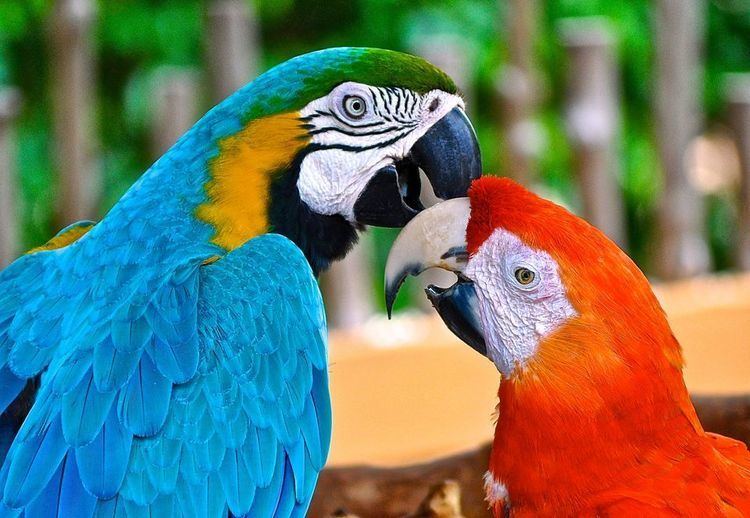
Of the many different Psittacidae (true parrots) genera, six are classified as macaws: Ara, Anodorhynchus, Cyanopsitta, Primolius, Orthopsittaca, and Diopsittaca. Previously, the members of the genus Primolius were placed in Propyrrhura, but the former is correct in accordance with ICZN rules. Macaws are native to Central America and North America (only Mexico), South America, and formerly the Caribbean. Most species are associated with forests, especially rainforests, but others prefer woodland or savannah-like habitats.

Proportionately larger beaks, long tails, and relatively bare, light-coloured, medial (facial patch) areas distinguish macaws from other parrots. Sometimes the facial patch is smaller in some species, and limited to a yellow patch around the eyes and a second patch near the base of the beak in the members of the genus Anodorhynchus. A macaw's facial feather pattern is as unique as a fingerprint.
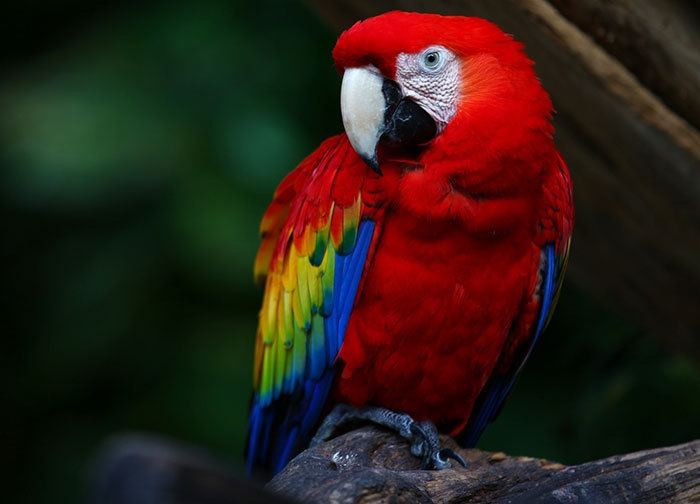
The largest macaws are the hyacinth, Buffon's (great green) and green-winged macaws. While still relatively large, macaws of the genera Cyanopsitta, Orthopsittaca and Primolius are significantly smaller than the members of Anodorhynchus and Ara. The smallest member of the family, the red-shouldered macaw, is no larger than some parakeets of the genus Aratinga.
Macaws, like other parrots, toucans and woodpeckers, are zygodactyl, having their first and fourth toes pointing backward.
Species in taxonomic order
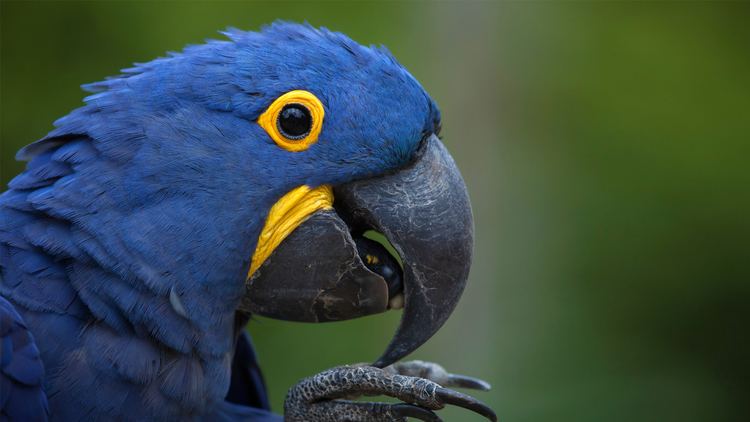
There are 19 species of macaws, including extinct and critically endangered species. In addition, there are several hypothetical extinct species that have been proposed based on very little evidence.
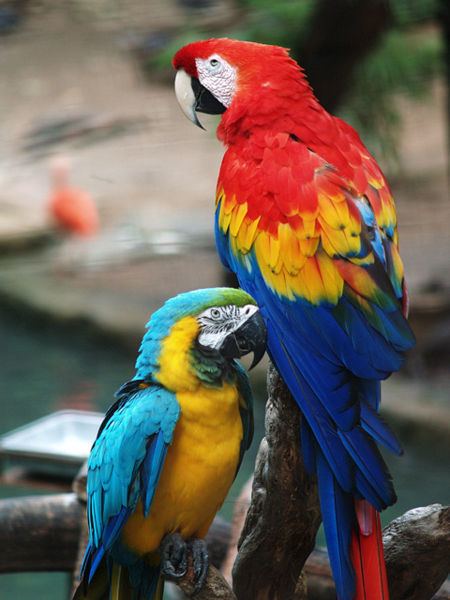
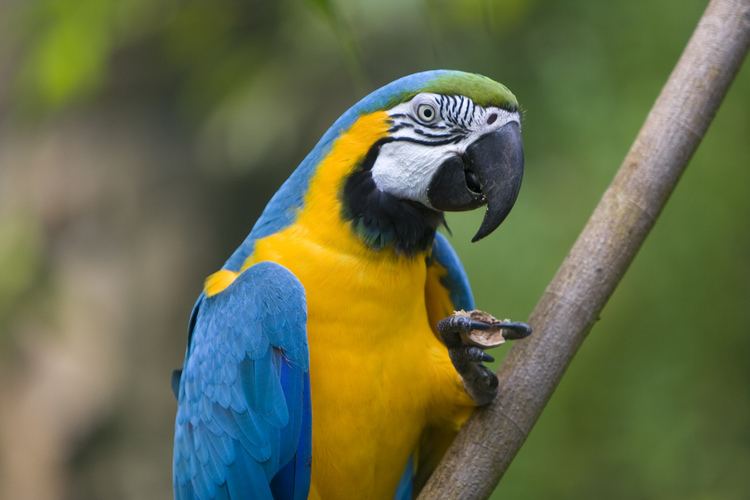
Hypothetical extinct species
Several hypothetical extinct species of macaws have been postulated based on little evidence, and they may have been subspecies, or familiar parrots that were imported onto an island and later wrongly presumed to have a separate identity.
Extinctions and conservation status
The majority of macaws are now endangered in the wild and a few are extinct. The Spix's macaw is now probably extinct in the wild. The glaucous macaw is also probably extinct, with only two reliable records of sightings in the 20th century. The greatest problems threatening the macaw population are the rapid rate of deforestation and illegal trapping for the bird trade.
International trade of all macaw species is regulated by the Convention on International Trade in Endangered Species of Wild Flora and Fauna (CITES). Some species of macaws—the scarlet macaw (Ara macao) as an example—are listed in the CITES Appendix I and may not be lawfully traded for commercial purposes. Other species, such as the red-shouldered macaw (Diopsittaca nobilis), are listed in Appendix II and may legally be traded commercially provided that certain controls are in place, including a non-detriment finding, establishment of an export quota, and issuing of export permits.
Hybrids
Sometimes macaws are hybridized for the pet trade.
Aviculturists have reported an over-abundance of female blue-and-yellow macaws in captivity, which differs from the general rule with captive macaws and other parrots, where the males are more abundant. This would explain why the blue and gold is the most commonly hybridised macaw, and why the hybridising trend took hold among macaws. Common macaw hybrids include the harlequin (Ara ararauna × Ara chloroptera), miligold macaw (Ara ararauna × Ara militaris) and the Catalina (known as rainbows in Australia, Ara ararauna × Ara macao). In addition, unusual but apparently healthy intergeneric hybrids between the hyacinth macaw and several of the larger Ara macaws have also occasionally been seen in captivity.
Diet and clay licks
Macaws eat a variety of foods including seeds, nuts, fruits, palm fruits, leaves, flowers, and stems. Wild species may forage widely, over 100 km (62 mi) for some of the larger species such as Ara araurana (blue and yellow macaw) and Ara ambigua (great green macaw), in search of seasonally available foods.
Some foods eaten by macaws in certain regions in the wild are said to contain toxic or caustic substances which they are able to digest. It has been suggested that parrots and macaws in the Amazon Basin eat clay from exposed river banks to neutralize these toxins. In the western Amazon hundreds of macaws and other parrots descend to exposed river banks to consume clay on an almost daily basis – except on rainy days. Donald Brightsmith, the principal investigator of the Tambopata Macaw Project, located at the Tambopata Research Center (TRC) in Peru, has studied the clay eating behaviour of parrots at clay licks in Peru. He and fellow investigators found that the soils macaws choose to consume at the clay licks do not have higher levels of cation-exchange capacity(ability to absorb toxins) than that of unused areas of the clay licks and thus the parrots could not be using the clay to neutralize ingested food toxins. Rather, the macaws and other bird and animal species prefer clays with higher levels of sodium. Sodium is a vital element that is scarce in environments greater than 100 kilometres from the ocean. The distribution of clay licks across South America further supports this hypothesis – as the largest and most species rich clay licks are found on the western side of the Amazon Basin far from oceanic influences. Salt-enriched (NaCl) oceanic aerosols are the main source of environmental sodium near coasts and this decreases drastically farther inland.
Clay-eating behaviour by macaws is not seen outside the western Amazon region, even though macaws in these areas consume some toxic foods such as the seeds of Hura crepitans, or sandbox tree, which have toxic sap. Species of parrot that consume more seeds, which potentially have more toxins, do not use clay licks more than species that eat a greater proportion of flowers or fruit in their diets.
Studies at TRC have shown a correlation between clay-lick use and the breeding season. Contents of nestling crop samples show a high percentage of clay fed to them by their parents. Calcium for egg development – another hypothesis – does not appear to be a reason for geophagy during this period as peak usage is after the hatching of eggs.
Another theory is that the birds, as well as other herbivorous animals, use the clay licks as a source of cobalamin, otherwise known as vitamin B12.
